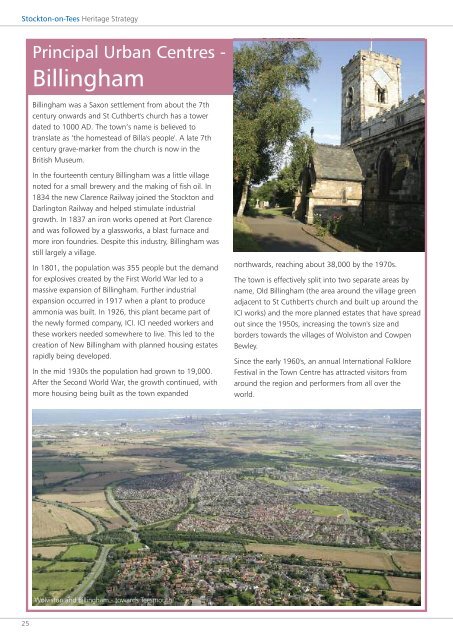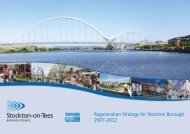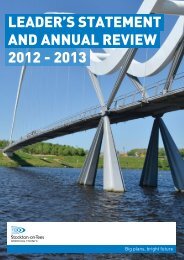Heritage Strategy - Stockton-on-Tees Borough Council
Heritage Strategy - Stockton-on-Tees Borough Council
Heritage Strategy - Stockton-on-Tees Borough Council
You also want an ePaper? Increase the reach of your titles
YUMPU automatically turns print PDFs into web optimized ePapers that Google loves.
stockt<strong>on</strong>-<strong>on</strong>-<strong>Tees</strong> <str<strong>on</strong>g>Heritage</str<strong>on</strong>g> <str<strong>on</strong>g>Strategy</str<strong>on</strong>g><br />
Principal Urban centres -<br />
billingham<br />
Billingham was a Sax<strong>on</strong> settlement from about the 7th<br />
century <strong>on</strong>wards and St Cuthbert's church has a tower<br />
dated to 1000 AD. The town’s name is believed to<br />
translate as ‘the homestead of Billa's people'. A late 7th<br />
century grave-marker from the church is now in the<br />
British Museum.<br />
In the fourteenth century Billingham was a little village<br />
noted for a small brewery and the making of fish oil. In<br />
1834 the new Clarence Railway joined the <str<strong>on</strong>g>Stockt<strong>on</strong></str<strong>on</strong>g> and<br />
Darlingt<strong>on</strong> Railway and helped stimulate industrial<br />
growth. In 1837 an ir<strong>on</strong> works opened at Port Clarence<br />
and was followed by a glassworks, a blast furnace and<br />
more ir<strong>on</strong> foundries. Despite this industry, Billingham was<br />
still largely a village.<br />
In 1801, the populati<strong>on</strong> was 355 people but the demand<br />
for explosives created by the First World War led to a<br />
massive expansi<strong>on</strong> of Billingham. Further industrial<br />
expansi<strong>on</strong> occurred in 1917 when a plant to produce<br />
amm<strong>on</strong>ia was built. In 1926, this plant became part of<br />
the newly formed company, ICI. ICI needed workers and<br />
these workers needed somewhere to live. This led to the<br />
creati<strong>on</strong> of New Billingham with planned housing estates<br />
rapidly being developed.<br />
In the mid 1930s the populati<strong>on</strong> had grown to 19,000.<br />
After the Sec<strong>on</strong>d World War, the growth c<strong>on</strong>tinued, with<br />
more housing being built as the town expanded<br />
northwards, reaching about 38,000 by the 1970s.<br />
The town is effectively split into two separate areas by<br />
name, Old Billingham (the area around the village green<br />
adjacent to St Cuthbert's church and built up around the<br />
ICI works) and the more planned estates that have spread<br />
out since the 1950s, increasing the town's size and<br />
borders towards the villages of Wolvist<strong>on</strong> and Cowpen<br />
Bewley.<br />
Since the early 1960's, an annual Internati<strong>on</strong>al Folklore<br />
Festival in the Town Centre has attracted visitors from<br />
around the regi<strong>on</strong> and performers from all over the<br />
world.<br />
Wolvist<strong>on</strong> and Billingham - towards <strong>Tees</strong>mouth<br />
25

















